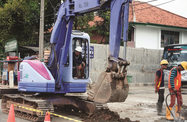Mongolia: Mortgage rate cut to boost house sales
Home ownership rates in Mongolia are set to climb in 2013 and beyond as a new state-backed mortgage scheme has improved access to low-cost loans, though demand for housing could push up prices if the construction sector cannot keep up a smooth flow of units onto the market.
In mid-June, the Bank of Mongolia introduced a new home loan scheme, approved by the cabinet earlier that month, which reduced interest rates on mortgages for many applicants by almost 50%. For prospective homebuyers who qualify for the new scheme, interest rates will be fixed at 8%, with a 1% plus-or-minus variable to factor in inflation, well down on the standard 15% rates for mortgages previously applied.
To qualify for a low-cost loan, buyers need to be in full employment, the repayments must not exceed 45% of their monthly income and the size of the home to be purchased must be less than 80 sq metres. Buyers must also be able to make an up-front payment of 10-30% of the face value of their property, and the repayment period cannot exceed 20 years.
By limiting the size of qualifying apartments, the government has provided an incentive to the local construction industry to increase the roll-out of smaller units, while also offering first-time homebuyers the chance to enter the property market at the lower end of the market. Sandagdorj Bold, senior economist at the Bank of Mongolia, told Bloomberg on June 12 that the impact of the mortgage programme will be felt across the economy. “The intended purpose is to support the middle class and support the long-term sustainable economic growth by increasing the savings of the middle class.”
The move to lower interest rates could have a major impact on the market, according to Ya. Purevsuren, vice president for finance and investment at MCS Group, a large local conglomerate. “People are realising mortgages are hard to get,’’ Purevsuren told OBG. “Mortgages are a huge constraint in this market.” The down payment can also be a challenge, with many commercial banks requiring 30% of the property’s price.
The extent of built-up demand was apparent immediately, with more than $63.5m worth of mortgage applications lodged within the first week of the scheme, according to data from the Bank of Mongolia. The number of existing mortgage holders seeking to benefit from the lower interest rates and extended terms of repayment was even more pronounced, with just over $410m worth of requests to refinance mortgages submitted, of which $137m was shifted to the new rate. By comparison, the total value of outstanding home loans amounts to around $630m.
The government has taken other steps to make housing affordable for middle-class buyers, including the provision of soft loans to construction firms. In January the Ministry of Construction and Urban Development and the Bank of Mongolia signed an agreement to provide low-interest loans to domestic suppliers of building materials. The central bank initially said that it would grant MNT370bn ($259m), but in May the government announced that an additional MNT100bn ($70m) would be made available to firms selling cement and reinforcement materials.
This scheme has the potential to keep the rise in housing prices in check. According to the local media, around 90% of construction companies finance their operations through high-cost loans from commercial banks. The government has said that the goal of this programme is to stabilise the per sq metre price of apartments at around MNT1m-1.5m ($700-1050).
Developers participating at a housing exhibition in April said that it would be “possible” to sell homes at a price of less than MNT1m ($700) per sq metre, but they added that most of their properties were selling for more than MNT1.3m ($910) per sq metre. Prices could be lower, they noted, if the government were to invest in infrastructure improvements such as water and sewage pipes, power lines and heating grids.
Investments in roads and other transport infrastructure would also help to drive down the cost of building materials. Mongolia is landlocked, and also distant from suppliers that could provide what it cannot source in-country. Overland transportation routes are swamped by existing demand, and building supplies compete with mining equipment and other imports on available train wagons.
Mongolia faces the challenge of urban migration, and residential real estate supply has not kept up with demand. Affordable housing may not have the allure of luxury developments, but there is substantial demand and very little supply to date. If the government helps to keep costs in check, even low-cost home construction should provide reasonable returns on investment.


